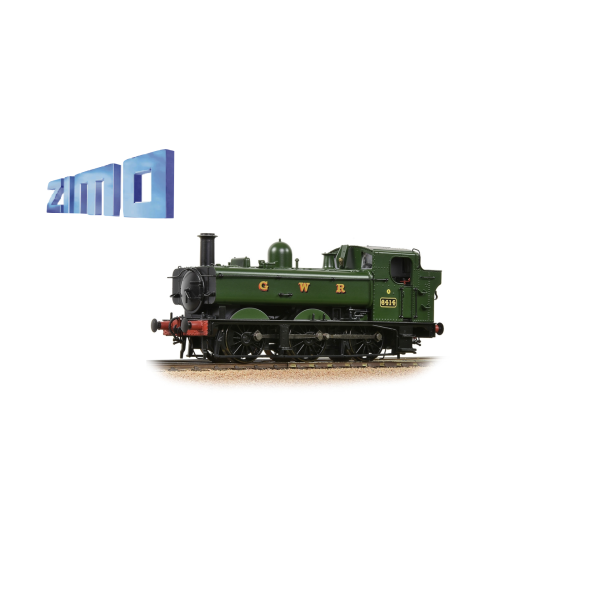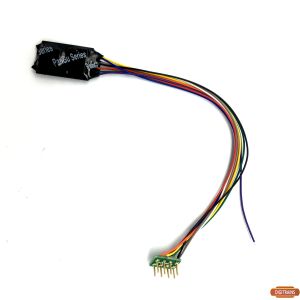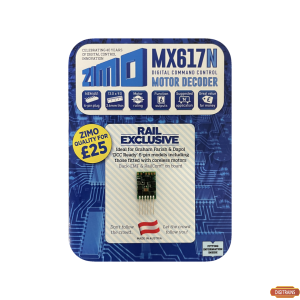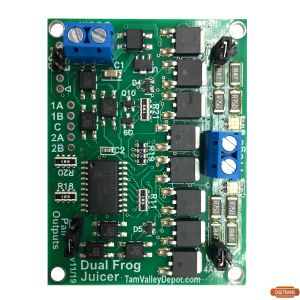ZS043P NEW Pannier ZIMO Protodrive Enhanced V 21.31
Please read these notes to ensure you obtain the maximum satisfaction from your new Pannier sound fitted loco. The sounds should work perfectly as supplied, but you can fine tune them further through the programming function on your DCC controller.
Operating Your ZIMO Sound Decoder.
As supplied, the decoder will operate in ‘Full Gear’ i.e. steam admitted for the whole of the piston stroke, but you can switch between the available sounds using your DCC controller by following the straightforward instructions below.
This project uses ZIMO’s ability to switch between ‘full gear’ sounds, typical of starting a heavy train, or steam ‘cut-off’ sounds as the driver reduces the duration of steam input to the cylinders.
These are all fully configured within the project, waiting for you to operate the ‘reverser’ control (F5).You can revert back at any time.
All the CVs have been optimised for the Bachmann 94xx Pannier Tank model, but you may want to make minor adjustments to perfect it for your individual tastes.
There are many Functions, most of which have an individual sound attached. Some will perform a physical function (e.g. turning on the lamps, if fitted), and some will do both depending on equipment installed). Please study the list below.
In any of the driving sound sets, increasing the speed step by 1 or more will produce an acceleration sound for a few seconds. If you wish continuous acceleration, ease the throttle setting upwards rather than 0-128 in one jump!
Similarly, in each sound set, a reduction of 1 speed step or more will stop the exhaust beats and the loco will ‘coast’ (or drift) for a few seconds before resuming exhaust beats. Continuous drifting can be simulated by easing the throttle settings down, one step at a time.
Many sounds may be modified (including changing or removing them) individually, and the volume levels may also be varied to suit your own needs. For this, and much more information on your decoder’s outstanding abilities, please download the latest Small Decoder Manual from: www.zimo.at/web2010/
Reverser Control – F5
This project has two reverser positions in each direction. The default setting is ‘full gear’ but a cut-off of around 60% is available with the F 5 key which operates as a reverser. The exhaust sounds are modified as follows:
Full Gear. This is the one to use to start with a heavy train on the hook. Steam is admitted to the cylinders for the full piston stroke. The chuffs are loud and harsh as steam at virtually boiler pressure is exhausted. This configuration gives the maximum power, but is the least efficient setting.
Cut-Off. With a light engine movement, or when a train has been ‘lifted’, the driver will reduce the duration for which steam is admitted to the cylinders. The steam still provides power for the rest of the stroke by expansion. This reduces the pressure of the exhausted steam, resulting in softer more subdued Chuffing.
We have provided the reverser so that you can change the sounds to simulate reality more closely. In model form, there’s nothing to stop you from using it to vary the exhaust sounds simply to add interest.
Special Zimo Function on F16, Light engine
The Inertia and Momentum settings by default are set high, producing acceleration and deceleration rates expected from a heavy train. A light engine can accelerate more rapidly, so when engaged F17 will instantly reduce inertia and momentum to provide more brisk acceleration and deceleration.
Tip. You can also use F16 to reduce the stopping distance without using, or use in conjunction with the Brake Key
Working Loco Brakes
In a real locomotive, acceleration, speed and deceleration are under control of the driver. He will use his experience of the locomotive type, the train weight and knowledge of the route (or ‘Road’) to anticipate the control movements required to achieve the required performance and safety.
Deceleration is often achieved by reducing power only, allowing the locomotive to ‘drift’ to lower speeds. Typically, the brakes are only used to fine tune this rate of deceleration or make a halt at a specific point. At other times, strong braking will be required even at high speed.
A rare decoder feature, the ability to apply a variable braking force to increase the rate of deceleration when desired, is incorporated into this model.
The objective is to simulate the real driving experience as closely as possible, so here’s how it works.
With the locomotive moving, reduce the throttle setting to zero. The loco will drift, gradually decelerating and the exhaust sound will fade into rod clanking.
Engage Brakes with F key 2.
A short ‘dab’ will produce a short brake application sound and a modest increase in deceleration rate. You can think of this as ‘Speed Trimming’. This can be repeated if required, and is entirely prototypical in operation.
A longer application will produce a longer brake application sound and a higher rate of deceleration.
The longer the Brake Key is held ‘on’, the greater the brake force applied.
Holding the Brake Key down continuously will produce a long brake application sound and the loco will perform a prototypically modelled emergency stop, i.e. Brake force increases with time; maximum brake force and deceleration rate is achieved immediately prior to coming to a halt.
Automatic brake squeal will accompany the final moments before halting.
The Brake Key can also be used to simulate brake testing.
The Brake Key may also be operated during deceleration between different speeds, e.g. speed restricted areas.
In this case, reduce the throttle to a suitable lower setting. The engine sound will change according to the features described earlier and the model will gradually decelerate. To increase the rate of deceleration, use the Brake Key as before, and the speed of the loco will be ‘trimmed’ to the newly selected speed step.
Please note that real locos do not stop dead even during an emergency stop. To reflect this, an emergency stop will be reasonably abrupt but not sudden.
If your DCC controller is equipped with a ‘panic button’ to avert imminent catastrophe, this will still operate as usual, and will have more immediate, though less prototypical, effect than the Brake Key.
Please note that the inclusion of the Brake Key allows high inertia settings in CV4. This produces a realistic drawn out drifting action; use the brake key to stop the model accurately when required, e.g. signals at danger or station stops.
Enhanced Sound Features
I have changed the way in which some sounds work or are triggered in order to enhance the simulation of real railway sounds.
Flange Squeal.
Enabled with the F Key 9. If it is not engaged, the Flange sounds will not play under any circumstances.
If the key is engaged, sounds will operate in the following automated way:
Loco is stationary or comes to a halt. The wheels are not turning and so there would be no flange squeal in reality. No flange sound will play in your model.
Loco is moving slowly. A slow speed flange squeal will play.
Loco is moving more quickly. A faster speed flange squeal will play.
Loco is moving very quickly. Flange squeal ceases until speed drops below the threshold set.
Wagons Snatching and Buffering
Enabled with F Key 13; if it not engaged, the wagon Snatching and Buffering sounds will not play under any circumstances.
If the key is engaged, and the Light Engine Mode (F key 16) is also engaged, the sounds will not play under any circumstances. (No wagons coupled in Light Engine Mode).
If the key is engaged, and the Light Engine Mode (F key 16) is not engaged, sounds will operate in the following automated way:
Loco is stationary. The sounds are not played.
Loco moves off/accelerates gently. The sounds are not played.
Loco moves off/accelerates more rapidly. The sound of the couplings taking up slack as the train stretches plays. This is also the case if the loco accelerates further when already moving.
Loco decelerates gently. The sounds are not played.
Loco decelerates more rapidly. The sound of several wagons buffering up is played each time.
Loco comes to a halt with the Brake Key (F key 2) engaged. The sound of several wagons buffering up is played after it comes to a halt.
Unfitted Freight Mode
Engage F17 to enable this mode. The top speed will be reduced to approximately 25 mph scale speed, which is the typical maximum speed allowed for unfitted (non-braked) trains. All features and sounds will work as before, but greater throttle movement will be required for the full range of available speeds. Disengage to revert back to normal. The sounds will automatically adjust whenever this mode is changed.
Pinned Brakes
Considerable skill was required from drivers of unfitted freight trains, and a high degree of co-operation between drivers and guards to accomplish safe handling of trains where only the locomotive and the Brake Van had any way to apply a controlled, variable brake force during movement.
The potential for a ‘run-away train’ was always present, the risk increasing with the unbraked weight and the severity of any down gradient.
It was common practice for the train to be halted at the top. Under the supervision of the guard the manual brake levers of some or all of the wagons would then be ‘pinned down’ in the on or partially on positions until satisfied that the combination of pinned brakes and those of the locomotive and brake van would provide sufficient retardation to allow a safe descent.
The aim was to achieve enough resistance to movement so that the locomotive was required to actively draw the train down the incline.
After traversing the danger zone, the train would again be halted and the wagon brakes released, or unpinned, before the train continued on its way.
In view of the increased friction the wagon brakes would be squealing during this manoeuvre.
So that you can faithfully re-create these events, your model is equipped with the sound of wagon brakes continuously squealing, but the feature can only be operated under prototypical conditions.
- Light Engine mode must not be enabled. (F16 not engaged)
- The train must be in Unfitted Freight Mode (F17 engaged).
- The train must be halted.
- Engage F18 to enable ‘Pinned Brake’ simulation. There will be no sound until the train is moved.
- At the foot of the (real or imagined) downward incline the train must again be halted. The wagon brake squeal sound will cease but will recommence if the train is moved again whilst F18 is engaged.
- When the train is stationary, disengage F18. Any subsequent movement will be made without the brakes squealing.
Please note that any attempt to operate this feature whilst the train is in motion or without F17 being engaged will be unsuccessful. This is intentional and is designed to eliminate the possibility of inadvertent triggering of this sound.
Speed Related Detonators
F key 11 enables the warning Detonators to sound. The first explosion is heard immediately, but the time for the subsequent two alerts in the series will depend upon the road speed of the loco.
Since the detonators would be placed at 20m intervals, the faster the road speed, the quicker the sound will repeat.
The appropriate time interval will be calculated by the decoder.
So, when you hear the first ‘bang’, reduce the throttle to zero and hit the Brake Key (F2) for an emergency stop. If you manage to stop the loco in time, you may prevent subsequent detonations.
F Key 11 must be disengaged and road speed reduced to zero before you will be able to operate this feature again.
Functioning Handbrake
When F22 is engaged, the sound of the handbrake being ‘wound on’ will be heard. When this sound stops, the model will no longer be drivable.
To release, disengage F22. The sound of the handbrake being ‘wound off’ will be heard. When this sound ends, you may drive the loco (subject to the status of F2)
Shunt Mode
Shunt mode in on F Key 26. Inertia and momentum are reduced to zero. This gives very fine control if required. The sounds will change automatically to suit the circumstances.
Live Volume Control
Provide the sound is switched on and the ‘fade’ button is not active, it is possible to change the overall volume to suit changing needs.
Engage F27 and the sound levels will gradually reduce, eventually to silence
Engage F28 and the sound levels will gradually increase, eventually to maximum.
In each case, disengage the F key when the desired level is attained. Set F27 and F28 as ‘momentary’ if your DCC controller allows you to do so.
Note: If the volume controls appear not to function, check that F19, F27 and F28 are disengaged before making a further attempt.
Coasting Sound Volume
You can independently change the volume of the sounds played when the loco is drifting (coasting) to suit your requirements.
CV286 = 180 is the project default. Higher values will increase volume; lower values will reduce volume relative to the other sounds.
GWR Whistles
In common with GWR practice, Pannier Tank locos were fitted with two whistles, one being the high pitched whistle usually associated with GWR and used for all normal signalling purposes. The second, lower tone whistle was provided for communication with the Guard, often regarding the need for the Brake Van’s hand brake to be applied.
Your model is equipped with the sound of each whistle. There are varied durations of each tone available, 10 in all. Five whistles are already assigned to F keys. You may audition, select and load each of them using the CV numbers and values shown in the Functions List below.
These are the whistle IDs and their descriptions:
145 Pannier 5 Toots Hi Rev.wav
146 Pannier Hi Lo Toot Toot 2 Rev.wav
147 Pannier High Long Rev.wav
148 Pannier Long and Short Low Rev.wav
149 Pannier Long and Short Rev.wav
150 Pannier Low Long Rev.wav
151 Pannier Low Toot 1 Rev.wav
152 Pannier Toot Rev.wav
153 Pannier Toot Toot 1 Rev.wav
154 Pannier Toot Toot 2 Rev.wav
Function Keys List There are 29 Function Keys used in this sound project. Please see below.
Some of the sounds have a finite length and will play from start to finish when selected. Other sounds will ‘loop’ until switched off, whilst others will vary in length, depending on how you operate the F keys on your DCC controller. Some keys have a control function rather than a sound.
|
Key Number
|
Sound or Control Function
|
Volume
CV
|
Sound ID
CV
|
Alternative Whistles
Default in Bold
|
|
F0
|
Lighting Control (If fitted)
|
|
|
|
|
F1
|
Sound on/off
|
|
|
|
|
F2
|
Brake Key– see text for explanation
|
CV517
|
CV516
|
|
|
F3
|
Short Whistle
|
CV520
|
CV519
|
145,146,147,148,149,150,151,152,153,154
|
|
F4
|
Long Whistle
|
CV523
|
CV522
|
145,146,147,148,149,150,151,152,153,154
|
|
F5
|
Reverser Control
|
CV526
|
CV525
|
|
|
F6
|
Coal Shovelling
|
CV529
|
CV527
|
|
|
F7
|
Injector (This sound is also a random sound)
|
CV532
|
CV531
|
|
|
F8
|
Blower (This sound is also a random sound)
|
CV535
|
CV534
|
|
|
F9
|
Enable Speed Related Wheel Flange (see text)
|
-
|
-
|
|
|
F10
|
Low Toot Whistle
|
CV541
|
CV539
|
145,146,147,148,149,150,151,152,153,154
|
|
F11
|
Enable speed related Detonators (see text)
|
-
|
-
|
|
|
F12
|
Two Tone Toot
|
CV547
|
CV546
|
145,146,147,148,149,150,151,152,153,154
|
|
F13
|
Enable Automatic Wagons Snatching (see Text)
|
-
|
-
|
|
|
F14
|
Coupling
|
CV553
|
CV552
|
|
|
F15
|
Cylinder Drains Opened
|
CV556
|
CV555
|
|
|
F16
|
Light Engine Mode
|
CV559
|
CV558
|
|
|
F17
|
‘Unfitted Freight’ mode (see text)
|
-
|
-
|
|
|
F18
|
Brakes Pinned (see text)
|
-
|
-
|
|
|
F19
|
Fade All Sounds
|
-
|
|
|
|
F20
|
Safety Valves Lifted
|
CV674
|
CV673
|
|
|
F21
|
Five Toots
|
CV677
|
CV676
|
145,146,147,148,149,150,151,152,153,154
|
|
F22
|
Functioning Handbrake
|
-
|
-
|
|
|
F23
|
Guard’s Whistle
|
CV683
|
CV682
|
|
|
F24
|
‘Guard Says Clear’
|
CV686
|
CV685
|
|
|
F25
|
‘Right o’ Way’
|
CV689
|
CV687
|
|
|
F26
|
Shunt Mode. (No Inertia or Momentum)
|
CV692
|
CV691
|
|
|
F27
|
Overall Volume Down
|
-
|
|
|
|
F28
|
Overall Volume Up
|
-
|
|
|
Volume setting range 1 – 255, higher values give louder sounds.
Paul Chetter
March 2021






